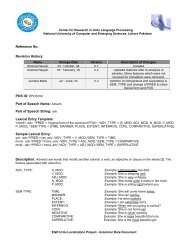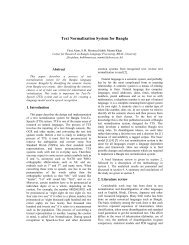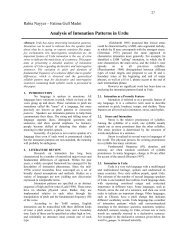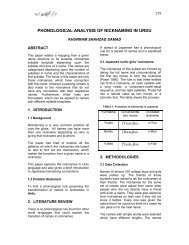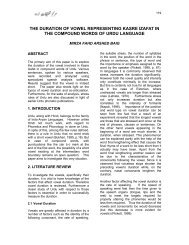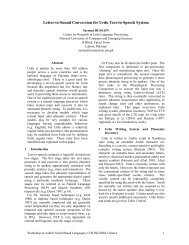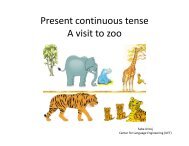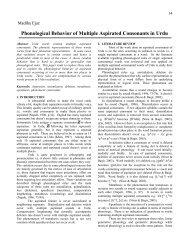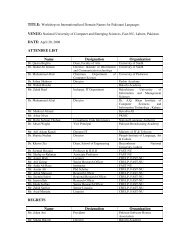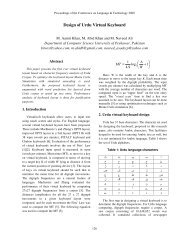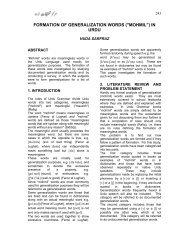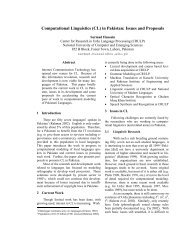SYLLABLE TEMPLATES IN URDU LANGUAGE - Center for ...
SYLLABLE TEMPLATES IN URDU LANGUAGE - Center for ...
SYLLABLE TEMPLATES IN URDU LANGUAGE - Center for ...
You also want an ePaper? Increase the reach of your titles
YUMPU automatically turns print PDFs into web optimized ePapers that Google loves.
190<br />
<strong>Center</strong> <strong>for</strong> Research in Urdu Language Processing<br />
According to Trask, two approaches<br />
dominate the syllable in the modern<br />
phonology (Trask, 1996, p.345): -<br />
(1) Syllable is a unit of neural programming,<br />
which can be reconstructed by the hearer<br />
from a variety of clues, in spite of the<br />
absence of any single phonetic correlate.<br />
(2) The syllable is a purely phonological unit<br />
consisting of a single peak of intrinsic<br />
sonority (though with qualifications <strong>for</strong> cases<br />
like English spit, which has two peaks).<br />
Summarily, the syllable can be thought of as<br />
an abstract unit of prosodic organization<br />
through which a language expresses much<br />
of its phonology, although the phonetic<br />
character of the syllable remains unclear<br />
(Kenstowicz, 1994, p.250). In much<br />
contemporary work, syllables are regarded<br />
as more fundamental than segments (Trask,<br />
1996, p.345).<br />
2.2. Syllable Structure<br />
The syllable typically consists of a short<br />
sequence of segments, most typically, a<br />
single vowel or a diphthong, possibly<br />
preceded and/or followed by one or more<br />
consonants. It is now usual to divide the<br />
syllable into an onset and a rhyme, with the<br />
rhyme further subdivided into a nucleus (or<br />
peak) and a coda (Trask, 1996, p.345).<br />
Onset<br />
Syllable<br />
Rhyme<br />
count and thus the location of tone or stress<br />
(Kenstowicz, 1994, p.253).<br />
2.3. Syllabification<br />
Syllabification, an analytical procedure <strong>for</strong><br />
dividing a phonological representation into a<br />
well-defined sequence of syllables, is guided<br />
by two well-established rules:<br />
1. Maximal Onset Principle states that a<br />
consonant, which may in principle occupy<br />
either rhyme or onset, will occupy onset<br />
position (Trask, 1996, p.217).<br />
2. Sonority Sequencing Principle states that<br />
the sonority profile of the syllable must slope<br />
outwards from the nucleus. In other words,<br />
the level of sonority must rise as we proceed<br />
from the beginning of the syllable to the<br />
nucleus and fall as we proceed from the<br />
nucleus to the end in accordance with the<br />
sonority hierarchy (Trask, 1996, p. 328).<br />
(The terms ‘sonority’ and ‘sonority hierarchy’<br />
are explained in the next section.)<br />
These two rules guide the <strong>for</strong>mation of<br />
complex onsets and codas. The notion of<br />
sonority perhaps deserves some elucidation.<br />
Sonority is a phonological property which<br />
lacks a simple phonetic correlate but can be<br />
associated with the output of the periodic<br />
acoustic energy of the segment or with the<br />
degree of aperture of the vocal tract (Trask,<br />
1996, p.327). Phonologists agree that the<br />
entire class of speech sounds can be scaled<br />
in order of their intrinsic sonority as below,<br />
with the vowels as most sonorous and the<br />
stops as least.<br />
Nucleus<br />
FIGURE 1 Structure of the syllable.<br />
Coda<br />
Sonority Hierarchy, (from least sonorous to<br />
most sonorous)<br />
oral stops, fricatives, nasals, liquids, glides,<br />
vowels<br />
2.4. Syllable Templates<br />
The nucleus plus coda <strong>for</strong>m a tighter bound<br />
than the onset plus nucleus (Kenstowicz,<br />
1994, p.252-253). Nucleus has the special<br />
status as the only obligatory constituent. It is<br />
the nucleus, which carries the tone or stress.<br />
Deletion of the nucleus typically relocates<br />
tone or stress, while loss of a consonantal<br />
onset or coda does not disturb the syllable<br />
In the earliest works introducing the syllable<br />
into phonology, syllabification was<br />
per<strong>for</strong>med by a battery of rules applied at a<br />
single point in the derivation or cyclically.<br />
Subsequently, an alternate view emerged<br />
according to which at least a rudimentary<br />
organization into syllables holds at all levels<br />
of the phonological representation. There is<br />
no point where syllabification originates or



